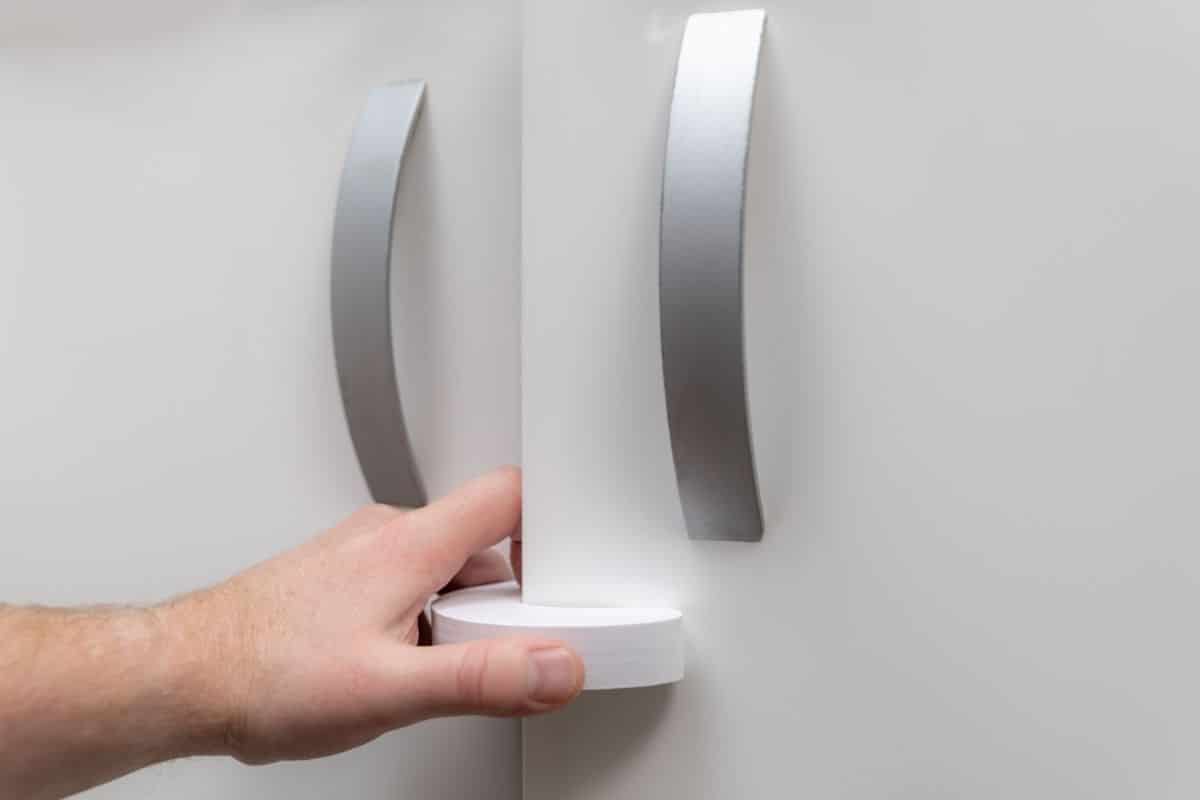Babies and toddlers are naturally curious individuals, and it’s only natural for them to want to explore their surroundings. However, there are potential hazards that are important to be aware of within your home, including interior and exterior doors.

Baby-proofing is crucial if you are taking care of a toddler, baby, or small child. The most important thing to remember when baby-proofing your home is that it should be done in stages.
Try to create a safe environment for your baby to play in and explore without causing harm to themselves or others.
As well as removing any sharp objects, hazards, and things that are low enough for them to grab, you should try to make things that can’t be easily removed much safer.
If you do have a little one, then the first step would be to install safety gates on stairs, so they cannot fall down the steps.
Doors can be hazardous because small fingers can easily get caught in the hinges. This can cause discomfort and injury.
It is essential to baby-proof the doors in your home so that your baby has some firm boundaries about where they can and cannot go.
This is a complete guide to making the external and internal doors around your home as safe as possible and baby-proof.
Baby Proofing Interior Doors

Consider how you are baby-proofing the inside of your home by taking a closer look at every room.
You could cover windows in areas where you think your child may climb, remove handles from cabinets if necessary, and install door guards. Keep your child safe in the home by making all the doors as safe as possible.
The interior doors can be made safer by installing door guards. These are available at hardware stores and come in different sizes and shapes. You need to make sure that these door guards fit snugly around the door frame.
Make sure that there is no gap between the guard and the door frame. Once installed, the door guard will prevent toddlers from opening the door. These are some of the best ways to baby-proof the doors inside your home.
Door Top Lock
This is an ideal option if you have a slightly older child who likes to pick locks whenever they get the chance. By installing a locking mechanism on top of the door, your baby, and child will be kept safe while they are exploring areas of the home.
Door top locks are ideal for adults to use without children showing an interest in them because they can be unlocked from either side of the door, and are easy to install with a handheld drill.
The biggest disadvantage to be aware of these locks is that they can actually cause damage to the door if it is forced open while locked. They can also be challenging for shorter adults to use as they are located on the top of the door.
Door Monkey
Another way of baby-proofing the doors inside your home is with a door monkey. These mechanisms lock the doors when they are slightly ajar.
This could be a great choice if you want to encourage air circulation while keeping a closer eye on your small child.
Door monkeys are easy to use and do not require any power tools to install. They have a basic lever mechanism, which means that adults and older children can unlock the doors with a simple movement.
Unfortunately, door monkeys are not adjustable to different door thicknesses. This means that they wouldn’t be ideal for households with slightly different door measurements.
However, door monkeys can be added at any height, which makes them ideal for shorter adults or those with older children who are more independent.
- For Door Knobs & Lever Handles
- Easy to Install - No Tools or Tape Required
- Very Portable
- Great for Dogs
Baby-Proof Handles
Additionally, you could try to protect your baby from a door by covering the handles. There are many baby-proof door handle covers that can only be opened by pinching the two sections together.
- New & Improved
- 5 Pack
- Deter Little Kids from Opening Doors
Other mechanisms involve screwing two sections together or limiting the movement of the door handle itself.
This can be useful if you want to stop your baby from getting where they are not supposed to be, but they are less useful on doors to rooms that you need to access regularly.
More potential hazards which can emerge within the home include children getting their small fingers trapped in door hinges.
There are many things you can do about this, but if you want to discourage this behavior, then you could cover the hinges in which they have shown an interest in.
Hinge covers are a great way of doing this, and greatly reducing the risk of getting their fingers stuck and getting hurt as a result.
- Finger Shield & Protector to Child Proof Your Door
- By Trusted Carlsbad Safety Products
Baby Proofing Exterior Doors

External doors are a little more challenging to baby-proof within the home. This is because they are usually made out of slightly more heavy-duty materials.
While you don’t need to go crazy and baby-proof every single door on your property if you don’t want to, it is always better to be safe than sorry.
It is recommended that you are taking the steps to baby-proof anywhere that your children play, or any rooms in your home that open onto external areas.
While they are less likely to be exploring the backyard as a small baby, your child will be running around in no time. It is definitely worth child-proofing exterior doors ahead of time so that you are prepared.
Additionally, baby-proofing exterior doors can make your home much more secure. Because these locks are often difficult to get into from the other side, baby-proofing measures can double up as burglar deterrents.
These are some of the best ways that you can baby-proof exterior doors.
Security Chain
Firstly, security chains are ideal on front doors or anywhere that opens up onto a main road.
They are also great options if you have older children whose friends like to visit because it will encourage them to check that the door is locked more consistently.
While there are many variants available, the majority of security locks feature a simple chain on the door which connects to a track attached to the frame.
Because there is minimal installation required, security chains are usually a safe bet for rental properties as long as the landlord is notified beforehand.
Most security chains can be installed higher than most children can reach, and they will only lock from the inside. This means that they are resistant to external forces tampering with the chain.
Consider adding a security chain if you want to make your home safer for your baby and as a way of protecting your household against thieves or other unwanted intruders.
Remember that security chains cannot be unlocked from the outside, so it can be a little more of a challenge if you live with roommates or multiple people who work on their own schedules. They will not want to find themselves locked out.
Security locks also allow you to open the door several inches wide, which allows you to see who is at the door and interact with them without actually letting them in.
This isn’t always the best idea for babies who are learning to walk, as they can try to squeeze through this gap. Make sure you are using additional baby-proofing measures like a stair gate in order to keep your little one safe.
Lever Handle Lock
If the exterior doors in your home have levered handle mechanisms, it’s critical that you are baby-proofing these.
This is because they are the easiest for babies, children, and toddlers to figure out how to use. In order to keep them safe, you could install lever handle locks.
These are easy to install and do not require any power tools. Consider adding lever handle locks to your exterior doors as a way of keeping your baby safe.
Some of these products have also been made with a decoy button, which can act as a useful distraction for older children and toddlers who want to test out the door handle anyway.
Because the door handle is unable to move, it is worth remembering that the door will not be able to open from the outside. This means that adults can be locked out if the lever handle lock has been accidentally left on.
Door Knob Lock
Similarly, homes that have round door knobs to exterior areas or internally could benefit from door knob locks. These handle covers, which were mentioned earlier, are ideal for covering any small, round handle and stopping children from turning it.
The way in which the cover has been designed also makes it harder for small hands to grip the handle at all, which is an ideal way of keeping your children in check when necessary.
Unlike security chains, most door knob locks are easy to install and remove without leaving any damage to the door.
These are a great choice if you want to set firm boundaries with your children and make sure that they are as safe as possible.
Another thing which makes these ideal is that they can even be packed away and brought with you on vacation. This can provide additional security and keep your children safe wherever you are in the world.
On the other hand, the biggest disadvantage of these locks is that they only work on smaller, round door handles.
Because of this, it is worth taking a closer look at the shape of the door handles within your home before purchasing the door knob locks.
In spite of this limiting factor, these are some of the easiest handle covers to use. They also provide security as well as keep your child from exploring areas that they shouldn’t be.
Types Of Doors
Baby-proofing different types of doors within the home can be challenging because of the different sizes, fittings, and shapes of doors. These are some of the most common doors seen within and outside the home.
French Doors
French doors create an open feel to any place which is warm and inviting. There are usually two doors next to each other, which open from the middle where the two meet. This can be inwards towards the center of a room, or towards the outdoors.
Depending on the style of handles that are used, there are different ways to baby-proof French doors. Simple solutions include drawer catches, lever handle locks, and door top locks.
Other ways to baby-proof your French doors include checking whether any glass panels are shatter-resistant. If not, then it is essential to install the laminate film on either side in order to prevent your child from getting severely injured.
Bi-Fold Doors
Another common door that is seen in many homes is the bi-fold door. These are doors that appear to be multiple panels connected when they open up.
This can make two rooms easily open up into one larger one, or make the backyard feel like another room during warm days.
They slide together when they are opened to completely open up a space. These need additional care when it comes to baby-proofing because children will be intrigued by the mechanism and are more likely to catch their fingers in bi-fold doors.
Consider investing in a high-quality sliding door lock to keep your little one protected from the contents of a bi-fold door cabinet, and from catching themselves when they are investigating.
Single Internal Doors
Single internal doors are some of the most common doors seen within many homes. These are relatively straightforward ways of separating rooms and establishing boundaries.
Internal doors are connected to frames with hinges on one side of the door.
These doors can be found in a range of colors, finishes, and sizes depending on your home and personal style.
Not only that, but there is a wide variety of handle shapes, colors, and finishes which can help bring a home together and bring out a sense of style.
Sliding Doors
These can be used as internal and external doors and are made out of a range of materials. Sliding doors are usually fitted onto a ‘track’ which is found on the top and bottom of the door.
This allows them to move easily within that range and function safely.
Because they are so popular in many homes, there is already a range of sliding door locks available. These have been one of the most effective methods of baby-proofing within the home, and come highly recommended.
Similarly to French doors, sliding doors occasionally come in glass panes.
Make sure these are made of shatter-resistant glass and add protective laminate film on either side so that you don’t have to worry about them breaking when they experience low amounts of force.
Dutch Doors
Dutch doors are a unique way to add character to the home, which can also be functional if you live in an area with more animals roaming around. This is because the door is split into two panels that can open separately or together.
These are a little more challenging to baby-proof, although many argue that Dutch doors can act as built-in baby gates.
However, if you are worried about your child figuring out how to open the lower panel, then it could be worth adding a deadbolt or simple door lock for peace of mind.
Pool Doors
These are crucial safety features that can prevent more serious injuries and even fatalities in the future.
Consider adding a pool door that automatically falls into the lock when left, in order to keep your children safe and ensure that they aren’t falling into the pool when you are not around to supervise them.
Pool doors on their own are widely recognized as safety features because they are only unlocked from the poolside.
This means that adults can reach around when necessary, but smaller children cannot. Always keep your children supervised when you are by the pool if you have one in your household.
Frequently Asked Questions
- Aside From The Doors, How Else Can I Baby-Proof My Home?The key to figuring out what could be hazardous to an infant is to change your perspective. You are used to seeing your home from your point of view. Try to think about what items a baby or toddler would find interesting and want to investigate. These should be the things that you are changing, removing, or protecting. For example, covering power outlets is a must. The small areas are too tempting for them to push their tiny fingers into. Outlet covers are affordable and easy to find, so it is definitely worth going around and putting them in every wall outlet. Prevent your child from emptying the kitchen cabinets using simple cabinet locks. These are ideal ways of stopping them from pulling things down that you don’t want them to touch. Think about which cabinets contain heavy cooking equipment and other tools, and make sure the locks are reinforced on these doors. Additionally, it could be worth covering the sharp edges of coffee tables and other pieces of furniture. This can allow you to avoid injuries caused by you or your child catching themselves. Corner covers are affordable and easy to install, so it is definitely worth doing before your baby starts to explore your home.
- Can I DIY Baby-Proof My Home?Absolutely, make the most out of the materials that are available to you and save a little money in the long run. A washcloth is surprisingly useful when you want to stop your child from pulling a door open or moving it. Simply slide it underneath the door, and it should keep it wedged in position. Another way is to place a washcloth between the door and the door jamb above the height of the handle. Cardboard and tape also make a great handle cover, which is ideal for stopping little ones from playing with the mechanism. Pool noodles can also be used to make protective covers for door handles or hinges. They are easy to cut to size, adjust, and keep everybody safe. Because they are used for flotation, pool noodles are incredibly lightweight, waterproof, and safe for babies and young children to bump their heads on without causing injury.
- How Can I Baby Proof Cabinets?The easiest way of protecting the contents of your cabinets from being emptied, and also preventing your child from getting into areas that you don’t want them to, is by adding cabinet covers and locking mechanisms. The majority of cabinet locks follow a simple mechanism that is easy to install as well as remove. It’s crucial to baby-proof your cabinets so that your child does not begin exploring areas that are not suitable for them. Consider adding cabinet locks within the kitchen, too. It is worth thinking about which cabinets have heavy equipment used in cooking, and other tools which could be harmful if your baby accesses them. These cabinets should be locked using secure mechanisms in order to provide as much protection as possible. Some cabinet locking equipment uses magnets, while others need a special key to activate. There are plenty of options to choose from online, and it is certainly worth taking a look.
Summary
There are so many ways that you can baby-proof doors within your home nowadays, that it can be difficult to choose a particular method that works best for you.
Consider the type of doors which you have in your home, and what type of locking mechanism would be the best fit.
If you are still unsure, it could be worth asking around and doing your own research into the highest-rated pieces of equipment.
This could also be a useful way of getting more detail about baby-proofing suggestions and recommendations for certain types of protective methods.
The great thing about these baby-proofing methods is that some of these are also ideal for preventing burglars and other unwanted guests. However, this means it is easier for adults to get locked out frequently.
It is worth finding a way of baby-proofing the interior and exterior doors in your home so that your child can freely explore their little world when they become more mobile and independent.
Make sure you are aware of your child’s personality and how they like to explore the world. This can impact the type of protective measures that are necessary within your home.
Remember that every child is different and has slightly different needs when it comes to exploring a safe environment.

Carly Link, a 33-year old mother of two toddlers. She is a parent and goes through a lot of the usual parenting difficulties herself. Carly shares all her experiences and knowledge about the best baby products through this blog.
















